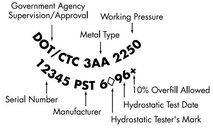SuperMiguel
Contributor
Does any of the numbering on a tank specify if they are LP/HP and what size? ie steel LP 108
Welcome to ScubaBoard, the world's largest scuba diving community. Registration is not required to read the forums, but we encourage you to join. Joining has its benefits and enables you to participate in the discussions.
Benefits of registering include

ya im just buying tanks from craiglist guy says they are 108, but size wise they are very similar to 104/100
